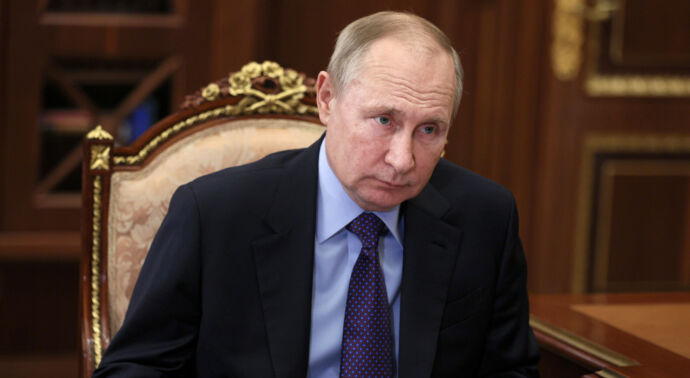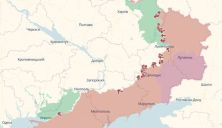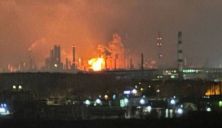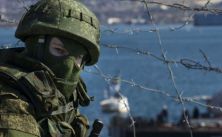Putin is right about one thing: A free, prosperous, democratic neighbor is a threat to his autocratic regime.
Children twirled around a skating rink just outside the president’s office in central Kyiv last week, while tourists took pictures of themselves in front of onion-domed, snow-dusted churches. The stores were full of people shopping for the New Year’s holiday and Orthodox Christmas, just as they always are at this time of year. The airports were crowded.
In other words, nothing unusual was happening in the Ukrainian capital – nothing except for the contingency plans being made for a possible Russian invasion. You can’t see them from the skating rink, but more than 100,000 Russian troops are gathered around Ukraine’s borders, along with weapons, armed vehicles, field hospitals, and Black Sea battleships. Quietly, newspaper editors are asking journalists to get their documents in order, just in case they suddenly need to travel to war zones. A Western diplomat told me that people she knows are “getting familiar with the concept of the ‘go bag,’” luggage that you have packed and ready in case of emergency. Gallows humor is everywhere. When, a few days ago, the Ukrainian Ministry of Defense called on women to register with the army, a plethora of jokes and memes made the rounds on people’s cellphones (this sort of thing: an image of a man lying in bed beside his wife and thinking, When will they get on with it and mobilize her?). People wonder out loud if the Russians will come before or after their planned winter vacations, and muse about whether they should change the dates accordingly.
A sense of unreality underlies all of these conversations. This moment is “strange –very, very strange,” Andriy Zagorodnyuk, a former Ukrainian defense minister, told me. For people in his country, the Russian threat is both dire and entirely unsurprising. Zagorodnyuk noted, as everybody in Kyiv does, that Russia already invaded Ukraine in early 2014. The Russians already occupy Crimea, which is Ukrainian territory. Fake “separatists,” supplied with Russian weapons, already control a small piece of eastern Ukraine, where they continue to fight the Ukrainian army, every day of every week. Some 14,000 people, including both soldiers and civilians, have already died in a conflict that continues only because the Russian government wants it to continue. Before I even broached the subject of whether Ukraine’s armed forces were ready for a new offensive, Andriy Yermak, President Volodymyr Zelensky’s chief of staff, reminded me: “We are in a state of constant military preparedness now for eight years.” Precisely because the Ukrainians are permanently under attack from Russia, it is usually the Ukrainians who shout loudest and call for international attention when the fighting escalates, or when the Russian army conducts massive military exercises along their borders, as it did last spring. But not this time.
This time, the alarm bells are ringing louder in Washington than in Kyiv. Secretary of State Antony Blinken began warning European allies about a possible new Russian invasion of Ukraine several weeks ago, and rumors of genuinely terrible things to come are flying around other Western capitals too. An invasion of Kyiv. An occupation of the country. The warnings seem to be based not just on the operational intelligence that many have seen – ominous photographs of military equipment and personnel accumulating around Ukraine’s borders – but on strategic intelligence, insights into the thinking of Kremlin insiders, which U.S. officials are allegedly showing their allies.
The alarm bells are also ringing because of the public behavior of Russian diplomats and officials, including President Vladimir Putin, who have spent the past couple of weeks accusing the United States and its allies of nonexistent aggression, such as imaginary plans to use chemical weapons against Russian-backed forces in eastern Ukraine. In fact, the sole aggressor in the region is Russia. Russian troops occupy not only parts of Ukraine but also parts of Georgia and Moldova; Russian “advisers” – latter-day Soviet commissars – now prop up a violent dictator in Belarus and may be about to annex that country too. Russian propaganda organs regularly issue violent threats. On New Year’s Eve, the Russian state news agency RIA Novosti tweeted a prediction: “Russia will destroy Ukraine within 10 minutes.”
Yet Russia insists on declaring that it fears NATO, a defensive alliance that mostly still exists, in 2022, because so many Europeans fear Russia. Putin has kept up this victim act for so many years that it has become banal; even many Russian experts now accept this performance as normal. But even if he believes it himself – even if he thinks that a handful of American soldiers rotating in and out of Poland pose some kind of physical threat to Moscow – that doesn’t mean the rest of the world has to accommodate his paranoia. It’s as if an American president repeatedly demanded that Canadian troops withdraw to the Arctic Circle on the grounds that their presence near Detroit constituted an unacceptable threat, and the rest of the world murmured agreement. In truth, the only logical explanation for this nonsensical posturing is that it is designed to justify a totally unprovoked invasion of Ukraine – or the Baltic states, or who knows where else – sometime in the future, and that’s why it has people worried.
In Kyiv, the novelty of this moment has produced, among the people I spoke with, two schools of thought. The skeptical school essentially thinks this whole situation might be a huge bluff: The Russians have deliberately set out to “scare the Americans,” perhaps even by leaking jazzed-up versions of Kremlin debates, in order to create pressure on Ukraine to change its constitution as the Russians would like, or to put Putin at the center of international attention, or to reestablish a Russian sphere of influence inside old Soviet borders. If this deliberately organized panic is a game, the skeptics say, the Russians have chalked up some wins. President Joe Biden has now twice held one-on-one conversations with Putin. A whole series of new Russian-American, Russian-NATO, and Russian-European security talks are scheduled for January. The tone of the diplomatic conversation around Ukraine has changed too. No longer are negotiators focused on the actual crisis in eastern Ukraine. Instead, the focus is on the Russian-American and Russian-NATO relationships.
So far, the U.S. has not yet given Putin anything else. Crucially, Biden and other senior administration officials have repeated several times an old Polish phrase, “nothing about us without us,” often used in the region. It means that decisions about Ukraine will not be made above the heads of Ukrainians. This is the only legitimate response to Putin’s threats, many of which are intended to achieve the opposite: get the U.S. to cut the Ukrainians out of the loop.
Members of a more pessimistic school of thought can also see that the saber-rattling has been carefully planned. But they fear that it reflects a genuine change: Perhaps Putin has finally decided to realize his long-standing dream of removing Ukraine from the map. Back in 2008, the Russian president told leaders gathered at a NATO summit that Ukraine is “not a state.” Last summer, he published a long essay arguing, among other things, that Russians and Ukrainians are “one people.” He then sent that essay to every soldier in the Russian army. Putin’s interest in invading, occupying, dividing, or otherwise destroying Ukraine – a country that has no nuclear weapons and could not invade Russia – is not strategic. It is emotional. The collapse of the Soviet Union was, in his words, “the greatest geopolitical catastrophe of the 20th century.” An expanded Russian occupation of Ukrainian territory might, in his view, help right that wrong.
Putin’s interest is also ideological. Every year, Ukraine becomes more confident, more united, more European. Every year, Ukraine inches a little bit closer to democracy and prosperity. What if it gets there? The idea of a flourishing, democratic Ukraine right on Russia’s doorstep is, for Putin, personally intolerable. Just as Ukrainian independence once seemed to Stalin to be a dire threat to his Bolshevik regime, so too would a successful modern Ukraine pose too great a challenge to Putin’s autocratic, sclerotic, kleptocratic, and ever more brutal political system. What if Russians start envying their Ukrainian neighbors? What if they decide they want a system like that too?
What the pessimists in Kyiv fear is this scenario: If Putin believes that Ukraine must be destroyed sooner or later; if he believes that historical wrongs must be righted; even if he just wants to gain back some of the popularity he has lost to COVID, corruption, and a poor economy, then he might have reasons to think that this is a good moment to do it. The Russians can see that the U.S. is divided, that Europe is exhausted by the pandemic and in need of Russian gas, that nobody is interested in new military adventures. They can also see that pro-Russian political forces in Ukraine are slowly losing ground, that Ukraine continues to invest in its military, and that others are doing so too.
Despite one very notable setback in Kyiv’s relationship with Washington – President Donald Trump tried to use military aid as a tool to blackmail Zelensky, and got impeached for it – the U.S. has continued to give Ukraine training and military assistance, including $450 million of defensive weapons this year. None of this would enable Ukraine to attack Russia, but it might help Ukrainians defend themselves. The Russians know this, and they could be calculating accordingly. One Russian analyst, Vladimir Frolov, notes that the costs of an invasion are steadily rising – because of Ukrainian economic growth, national consolidation, and military investment – and suggests that the price could rise more in the future, which is why Moscow should act now.
The Ukrainians are also thinking about that price, because they want to make it even higher: This is a subject about which both schools of thought in Kyiv agree. They know their country doesn’t have much of a navy or an air force, and it doesn’t have the most advanced anti-aircraft defenses either. But Ukraine has taken steps toward the creation of a territorial-defense force, run by the professional military but open to civilian volunteers. Small groups of enthusiasts, including recent veterans of the eastern conflict, have already formed their own training units. According to a survey conducted last spring, about 30 percent of Ukrainians (and 46 percent of men) say that they are willing to join an armed battle if an invasion occurs. In an interview in the Polish press, the former Ukrainian president Petro Poroshenko spelled it out clearly: Ukraine wants to ensure that “every city and every home becomes a fortress. And that thousands of coffins are sent back to Russia.”
The Ukrainian army itself is also prepared to split into smaller units, less easily targeted by advanced weapons. This might not stop a Russian bombing campaign, but that isn’t the point. The point is to make anyone considering a longer-term occupation think twice. As Zagorodnyuk noted, even the most fanatical Russian military planner must realize that once an invasion begins, events will spin out of control: “You don’t know how many people you are going to lose, how quickly you’re going to advance,” he said. “And you will certainly have trouble keeping control of anything you have invaded.”
But here is where a second gap emerges between Kyiv and Washington, as well as a second reason why this moment is so “very, very strange.” The Ukrainians, in the government and in the opposition, have no difficulty understanding that their conflict with Russia will involve violence, because it already does. Americans and Europeans, meanwhile, desperately want a solution involving nothing more than diplomacy and sanctions. On some level, Biden seems to understand that this might not be possible. He has publicly promised to reinforce Ukraine militarily in the event of an invasion, and also says he will move more arms and equipment into the eastern NATO states. Dmytro Kuleba, the Ukrainian foreign minister, told me that although he is grateful for this promise, it does raise a question: “If Washington sees the threat is imminent, then the best time to give us more military support to reinforce our armed forces is now, not after the invasion begins.”
In fact, the best time to give Ukraine more significant military support would have been eight years ago. Or five years ago. Or three years ago. If the U.S. had done so, then there would be a lesser threat, or no threat, of Russian invasion now, because Putin would calculate the risks differently. But Americans didn’t step in, because President Barack Obama never took Russia seriously, because Trump was on Putin’s side in the global contest between autocracy and democracy, and because Democrats and Republicans alike have had other things to think about since Biden took office.
As a nation, the U.S. has also started to forget the most important strategic lesson of the Cold War: Deterrence works. The idea that you invest in weapons in order to create peace has always sounded paradoxical, but decades of stability in Europe, thanks to both the creation of NATO in the 1950s and the expansion of NATO in the 1990s, prove this to be true. If you share a land mass with a bully, then make sure you are well armed enough to keep him at a safe distance.
Seen from Kyiv, the Western attitude toward Russia also looks incredibly naive. Since the Russian invasion of Georgia in 2008, Americans and Europeans have constantly been surprised by Russia, by Russian aggression, by Russian territorial ambitions, by Russian interference in our own political systems, by Russian attempts to destroy our alliances. But although Putin varies his tactics, his longer-term goals have been very clear for a very long time. He might use disinformation one year, gas-pipeline blackmail another, bribery or violence the next, but the endgame is always the same: reinforce his autocracy, undermine democracies – all democracies – and push Russian political influence as far as it will go. Break up NATO. Destroy the European Union. Remove American influence from Europe and everywhere else, forever.
Americans need to stop being surprised by this list of goals, and instead start writing a list of our own. We could start with this one: Help make Ukraine the successful, prosperous, Western-facing democracy that Putin so clearly fears. Don’t make decisions about Ukraine without Ukraine. And don’t do these things because it’s nice for the children at the ice-skating rink in Kyiv – do them because, in this case, Putin’s analysis is not paranoid: A successful, prosperous, Western-facing democratic Ukraine would indeed pose a dire ideological threat to Russia, as well as to Belarus and to other autocracies in the region and around the world. It would prove to the inhabitants of other autocracies that they can escape the influence of their greedy, brutal leaders. Losing Ukraine, by contrast, would reinforce dictators in Moscow, Minsk, and even Beijing.
Biden has said he wants to “prove that American democracy can still do big things and take on challenges that matter most.” Mostly, he means domestic challenges. But some challenges abroad will also affect American confidence and credibility well into the future. Helping Ukrainians defend Ukrainian democracy is one of them.
By Anne Applebaum










